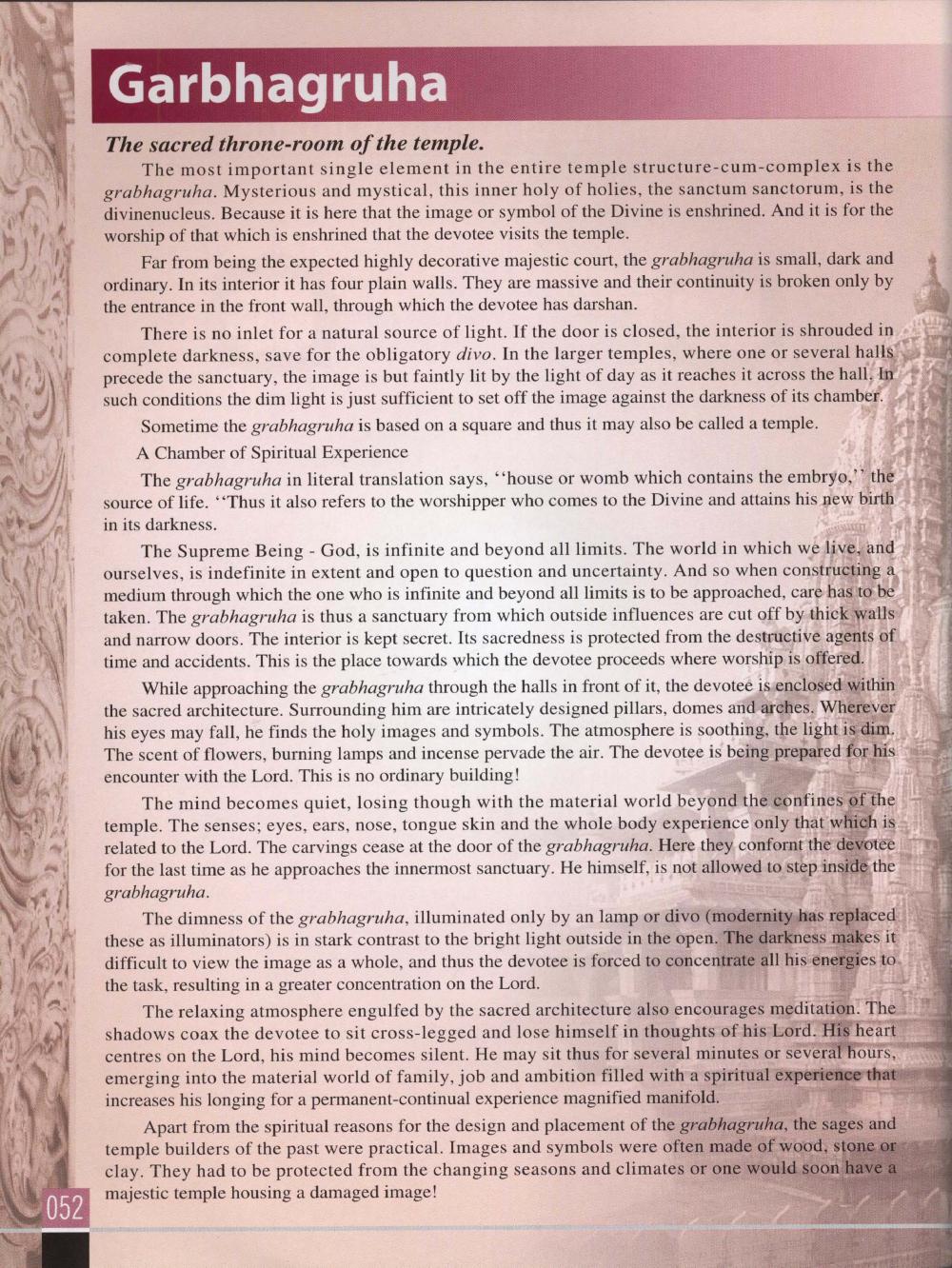________________
Garbhagruha
The sacred throne-room of the temple.
The most important single element in the entire temple structure-cum-complex is the grabhagruha. Mysterious and mystical, this inner holy of holies, the sanctum sanctorum, is the divinenucleus. Because it is here that the image or symbol of the Divine is enshrined. And it is for the worship of that which is enshrined that the devotee visits the temple.
Far from being the expected highly decorative majestic court, the grabhagruha is small, dark and ordinary. In its interior it has four plain walls. They are massive and their continuity is broken only by the entrance in the front wall, through which the devotee has darshan.
There is no inlet for a natural source of light. If the door is closed, the interior is shrouded in complete darkness, save for the obligatory divo. In the larger temples, where one or several halls precede the sanctuary, the image is but faintly lit by the light of day as it reaches it across the hall, In such conditions the dim light is just sufficient to set off the image against the darkness of its chamber. Sometime the grabhagruha is based on a square and thus it may also be called a temple.
A Chamber of Spiritual Experience
The grabhagruha in literal translation says, "house or womb which contains the embryo," the source of life. "Thus it also refers to the worshipper who comes to the Divine and attains his new birth in its darkness.
The Supreme Being - God, is infinite and beyond all limits. The world in which we live, and ourselves, is indefinite in extent and open to question and uncertainty. And so when constructing a medium through which the one who is infinite and beyond all limits is to be approached, care has to be taken. The grabhagruha is thus a sanctuary from which outside influences are cut off by thick walls and narrow doors. The interior is kept secret. Its sacredness is protected from the destructive agents of time and accidents. This is the place towards which the devotee proceeds where worship is offered.
While approaching the grabhagruha through the halls in front of it, the devotee is enclosed within the sacred architecture. Surrounding him are intricately designed pillars, domes and arches. Wherever his eyes may fall, he finds the holy images and symbols. The atmosphere is soothing, the light is dim. The scent of flowers, burning lamps and incense pervade the air. The devotee is being prepared for his encounter with the Lord. This is no ordinary building!
The mind becomes quiet, losing though with the material world beyond the confines of the temple. The senses; eyes, ears, nose, tongue skin and the whole body experience only that which is related to the Lord. The carvings cease at the door of the grabhagruha. Here they confornt the devotee for the last time as he approaches the innermost sanctuary. He himself, is not allowed to step inside the grabhagruha.
The dimness of the grabhagruha, illuminated only by an lamp or divo (modernity has replaced these as illuminators) is in stark contrast to the bright light outside in the open. The darkness makes it difficult to view the image as a whole, and thus the devotee is forced to concentrate all his energies to the task, resulting in a greater concentration on the Lord.
The relaxing atmosphere engulfed by the sacred architecture also encourages meditation. The shadows coax the devotee to sit cross-legged and lose himself in thoughts of his Lord. His heart centres on the Lord, his mind becomes silent. He may sit thus for several minutes or several hours, emerging into the material world of family, job and ambition filled with a spiritual experience that increases his longing for a permanent-continual experience magnified manifold.
Apart from the spiritual reasons for the design and placement of the grabhagruha, the sages and temple builders of the past were practical. Images and symbols were often made of wood, stone or clay. They had to be protected from the changing seasons and climates or one would soon have a majestic temple housing a damaged image!
052




